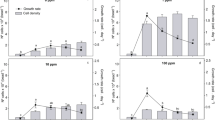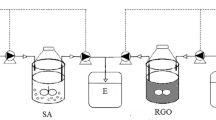Abstract
The feasibility of an anaerobic ammonium oxidation (anammox) process combined with a cell-immobilization technique for autotrophic nitrogen removal was investigated. Anammox biomass was cultivated from local activated sludge and achieved significant anammox activity in 6 months. The development of a mature anammox biomass was confirmed by fluorescence in situ hybridization (FISH) analysis and off-line activity measurements. The abundance fraction of the anammox bacteria determined by FISH analysis was estimated by software. The anaerobic ammonia oxidizers occupied almost half of the total cells. Additionally, the anammox biomass was granulated as spherical gel beads of 3–4 mm in diameter by using a cell-immobilization technique. The nitrogen removal activity was proved to be successfully retained in the beads, with about 80% of nitrogenous compounds (NH4 +, NO2 − and total nitrogen) removed after 48 h. These results offer a promising technique for the preservation of anammox microorganisms, the protection of them against the unfavorable surroundings, and the prevention of biomass washout towards the implementation of sustainable nitrogen elimination biotechnology. This is the first report on the immobilization of anammox biomass as gel beads.





Similar content being viewed by others
References
Ahn YH (2006) Sustainable nitrogen elimination biotechnologies: a review. Process Biochem 41:1709–1721
Amann RI, Ludwig W, Schleifer KH (1995) Phylogenetic identification and in situ detection of individual microbial cells without cultivation. Microbiol Rev 59:143–169
Amann RI, Binder BJ, Olson RJ, Chisholm SW, Devereux R, Stahl DA (1990) Combination of 16S rRNA-targeted oligonucleotide probes with flow cytometry for analyzing mixed microbial populations. Appl Environ Microbiol 56:1919–1925
Chang CC, Tseng SK (1998) Immobilization of Alcaligenes eutrophus using PVA crosslinked with sodium nitrate. Biotechnol Tech 12(12):865–868
Chen KC, Chen SJ, Houng JY (1996) Improvement of gas permeability of denitrifying PVA gel beads. Enzyme Microb Technol 18:502–506
Daims H, Brühl A, Amann R, Schleifer K-H, Wagner M (1999) The domain-specific probe EUB338 is insufficient for the detection of all bacteria: development and evaluation of a more comprehensive probe set. Syst Appl Microbiol 22:434–444
Hisashi N, Takako H, Kenji T, Masanori W, Ken S (1999) Treatment of aquarium water by denitrifying photosynthetic bacteria using immobilized polyvinyl alcohol beads. J Biosci Bioeng 87(2):189–193
Ho CM, Tseng SK, Chang YJ (2002) Simultaneous nitrification and denitrification using an autotrophic membrane-immobilized biofilm reactor. Lett Appl Microbiol 35:481–485
Hsieh YL, Tseng SK, Chang YJ (2002) Nitrification using polyvinyl alcohol-immobilizes nitrifying biofilm on an O2-enriching membrane. Biotechnol Lett 24:315–319
Kazuichi I, Yasuhiro D, Tatsuo S, Sachiko Y, Satoshi T (2006) Growth characteristic of anaerobic ammonium-oxidizing bacteria in an anaerobic biological filtrated reactor. Appl Microbiol Biotechnol 70:47–52
Kenji F, Joseph DR, Norihara Y, Hayato H (2003) Mass cultivation of anaerobic ammonium-oxidizing sludge using a novel nonwoven biomass carrier. J Chem Eng Japan 36:1163–1169
Lee CM, Lu CJ, Chang MS (1994) Effects of immobilized cells on the biodegradation of chlorinated phenols. Wat Sci Technol 30(9):87–90
Lu CJ, Lee CM, Huang CZ (1996) Biodegradation of chlorophenols by immobilized pure-culture microorganisms. Wat Sci Technol 34:67–72
Manz W, Amann R, Ludwig W, Wagner M, Schleifer KH (1992) Phylogenetic oligodeoxynucleotide probes for the major subclasses of proteobacteria: problems and solutions. Syst Appl Microbiol 15:593–600
Schmid MC, Maas B, Dapena A, van de Pas-Schoonen K, van de Vossenberg J, Kartal B, van Niftrik L, Schmidt I, Cirpus I, Kuenen JG, Wagner M, Damsté JSS, Kuypers M, Revsbech NP, Mendez R, Jetten MSM, Strous M (2005) Biomarkers for in situ detection of anaerobic ammonium-oxidizing (anammox) bacteria. Appl Environ Microbiol 71(4):1677–1684
Schmid M, Wachtmann UT, Klein M, Strous M, Juretschko S, Jetten MSM, Metzger JW, Schleifer KH, Wagner M (2000) Molecular evidence for genus level diversity of bacteria capable of catalyzing anaerobic ammonium oxidation. Syst Appl Microbiol 23:93–106
Schmid M, Walsh K, Webb R, Rijpstra WIC, van de Pas-Schoonen KT, Verbruggen MJ, Hill T, Moffett B, Fuerst J, Schouten S, Damste´ JSS, Harris J, Shaw P, Jetten MSM, Strous M (2003) Candidatus “Scalindua brodae,” sp.: nov., Candidatus “Scalindua wagneri,” sp. nov. two new species of anaerobic ammonium oxidizing bacteria. Syst Appl Microbiol 26:529–538
Seung HS, Suk SC, Kyungmoon P, Young JY (2005) Novel hybrid immobilization of microorganisms and its applications to biological denitrification. Enzyme Microb Technol 37:567–573
Sliekers AO, Derworth N, Gomez JLC, Strous M, Kuenen JG, Jetten MSM (2002) Completely autotrophic nitrogen removal over nitrite in one single reactor. Wat Res 36:2475–2482
Strous M, Heijnen JJ, Kuenen JG, Jetten MSM (1998) The sequencing batch reactor as a powerful tool for the study of slowly growing anaerobic ammonium-oxidizing microorganism. Appl Microbiol Biotechnol 50:589–596
Strous M, Kuenen JG, Jetten MSM (1999) Key physiology of anaerobic ammonia oxidation. Appl Environ Microbiol 65:3248–3250
Third KA, Paxman J, Schmid M, Strous M, Jetten MSM, Cord-Ruwisch R (2005) Enrichment of anammox from activated sludge and its application in CANON process. Microbol Ecol 49:236–244
Wang J, Kang J (2005) The characteristics of anaerobic ammonium oxidation (ANAMMOX) by granular sludge from an EGSB reactor. Process Biochem 40:1973–1978
Acknowledgments
The authors would like to thank the National Science Council of the Republic of China for financially supporting this research under Contract No. NSC 95-2211-E-002-145.
Author information
Authors and Affiliations
Corresponding author
Rights and permissions
About this article
Cite this article
Hsia, TH., Feng, YJ., Ho, CM. et al. PVA-alginate immobilized cells for anaerobic ammonium oxidation (anammox) process. J Ind Microbiol Biotechnol 35, 721–727 (2008). https://doi.org/10.1007/s10295-008-0336-7
Received:
Accepted:
Published:
Issue Date:
DOI: https://doi.org/10.1007/s10295-008-0336-7




